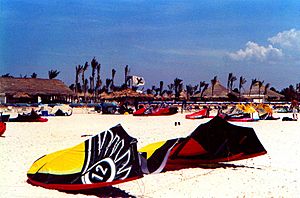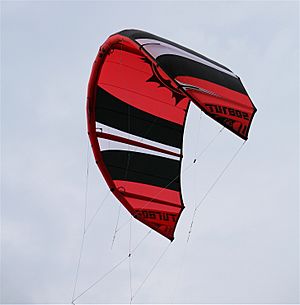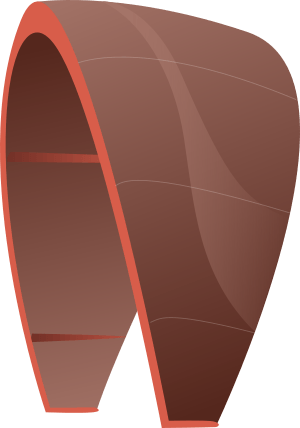Leading edge inflatable kite facts for kids

A leading edge inflatable kite (often called an LEI kite) is a special type of kite that has air-filled tubes, called bladders, to give it shape. These kites are super useful for sports where you need a lot of pull, like kitesurfing or kiteboarding. They are controlled using a bar and usually 2, 4, or 5 lines.
One of the best things about LEI kites is how well they work on water. Because of their inflatable bladders, they float! This means if your kite falls into the water, it won't sink or fill up with water. You can easily relaunch it and keep playing. LEI kites come in many sizes, usually from 5 to 18 square metres, depending on how much power you need.
Contents
Exploring Different LEI Kite Styles
LEI kites come in different designs, each with its own special features. These designs are grouped into four main types: C-kites, hybrid kites, delta kites, and bow kites.
Understanding C-Kites
C-kites are the oldest type of LEI kite used for sports that involve being pulled by a kite. They usually have four lines that connect directly to the corners of the kite. Some C-kites also have an extra fifth line for safety and to make relaunching easier.
What makes C-kites different is that they don't have any extra lines (called bridles) supporting the front edge of the kite. This design gives them a specific feel, which is why many experienced kiteboarders who do "wake-style" tricks prefer them.
Discovering SLE Kites
Most other LEI kites, like hybrid kites, bow kites, and delta kites, are part of a group called SLE-kites. SLE stands for "Supported Leading Edge." This means they use a system of lines, called a bridle, to support the front edge of the kite. This bridle helps control the kite's shape and how it flies.
Bow Kites: Power and Control
Bow kites are a type of SLE kite known for their unique shape. They have a curved back edge, which helps the kite flatten out when it's flying. This design, along with the bridles on the front edge, gives bow kites a lot of control.
One big advantage of bow kites is that you can "depower" them almost completely. This means you can quickly reduce the kite's pulling power, which is great for safety and managing strong winds. The special design of inflatable and bow kites was created by Dominique and Bruno Legaignoux.
Hybrid Kites: A Mix of Styles
Hybrid kites are a blend of C-kites and bow kites. Like bow kites, they use bridles to support their front edge. These bridles allow designers to create kites with different shapes, from very flat to more C-kite-like.
The way a hybrid kite flies depends on how much it's like a C-kite or a bow kite. The main difference between a hybrid and a bow kite is the shape of their back edge. A hybrid kite has a rounded (convex) back edge, while a bow kite has a curved inward (concave) back edge.
Delta Kites: More Power in the Middle
Delta kites are an improved version of the hybrid design. When laid flat, they look more like a triangle. This shape puts more of the kite's main fabric in the middle, which means more of the kite is exposed to the wind. This "projected area" gives delta kites more power.
Delta kites still use a bridle, though it might be very simple. They are often called C-shaped, but they are not traditional C-kites because they have a bridle. Some newer delta C-kites combine the strong performance of a C-kite with the easy control and fast turning of a delta kite.



